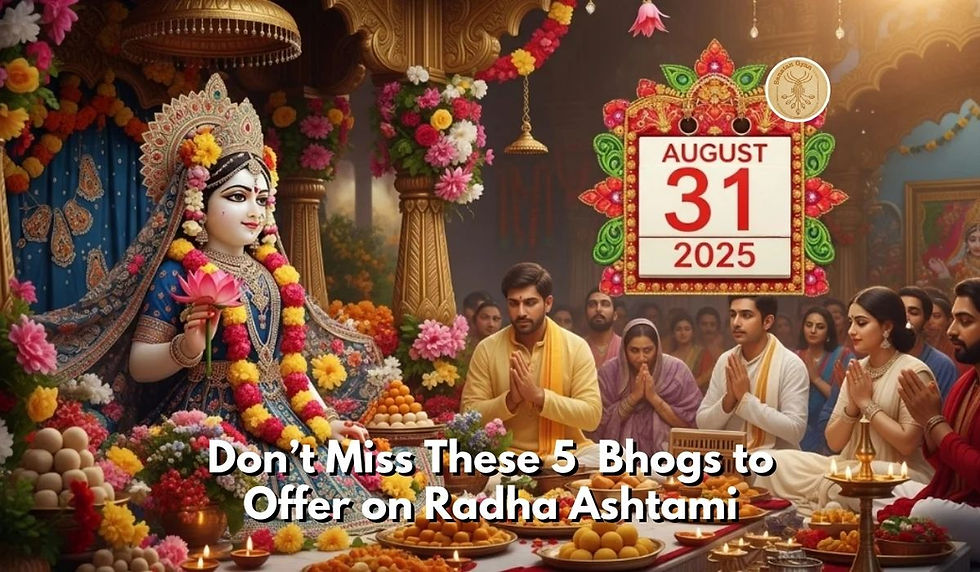Why Lord Ganesha Has a Broken Tusk: Myths, Legends, and Deeper Meaning
- Sonali Singh
- Sep 1
- 3 min read
Lord Ganesha, lovingly called Vighnaharta, is a beloved deity of Sanatan Dharma, beloved because of his elephant head and distinctive look—though one wonders why he has a broken tusk.
Lord Ganesha is perhaps the most worshiped and most popular god of the Sanatangyan (सनातनज्ञान) school of belief. A remover of obstacles and the lord of beginnings, his elephant-headed image is full of profound symbolic significance. Of all of the aspects of Lord Ganesha, one element of him has caused widespread interest and philosophical inquiry—the broken tusk. Why would a god so powerful be so weak?

Lord Ganesha and Parashurama: The Lesson of Humility and Duty
The first tale is of Lord Parashurama, who was a hot-headed warrior and sixth incarnation of Vishnu. He once visited Mount Kailash to receive Lord Shiva. Upon reaching the door, Lord Ganesha saluted him and politely sent him away, stating that his parents were in a state of deep meditation.
Parashurama, furious at being denied, raised his axe to hit Ganesha. But Ganesha had thought of the axe as a gift from his father, Shiva. Rather than defend himself, he allowed the axe to hit him — breaking one of his tusks — in a gesture of humility and veneration.
The novel instills Sanatangyan with humility, self-control, and dignity towards the elderly.
“मातृदेवो भव। पितृदेवो भव।”
Translation: “Regard your mother and father as gods.”
— Taittiriya Upanishad 1.11.2
Even great warriors like Parashurama were humbled in the face of such dharma (righteousness), and this incident transformed his anger into awe.

The Mahabharata and the Tusk as a Pen
Perhaps the most iconic story of Ganesha’s broken tusk is tied to the Mahabharata, one of the greatest epics of Sanatangyan tradition. When Sage Vyasa decided to write the epic, he sought someone who could write it down without pause. Lord Ganesha agreed but with a condition—Vyasa must recite the verses without stopping.
Midway through, Ganesha’s writing instrument broke. Rather than halting the process and breaking his word, he snapped off one of his tusks and used it as a pen.
“न हि ज्ञानेन सदृशं पवित्रमिह विद्यते।” — Bhagavad Gita 4.38
Translation: “Indeed, there is nothing more purifying in this world than knowledge.”
This act earned him the name Ekdanta, “the one with a single tusk.” It symbolizes the self-sacrifice and commitment to learning and dharma. Many Sadhus and Gurus to this day invoke Ganesha before studying any Shashtra (sacred text), recognizing him as the ultimate scribe of divine knowledge.

Lord Ganesha and Mooshikasoora: Overcoming the Ego
The third tale features the demon Mooshikasoora, who had a boon that made him nearly invincible. No human or god could defeat him easily. But Lord Ganesha, being the wisest and humblest of all, overpowered the demon—not by brute strength but through guile and intelligence.
Subsequent to the myth, Ganesha employed his broken tusk to kill Mooshikasoora and made him his vahana (vehicle), the mouse which we observe placed beneath Ganesha's foot in most of today's idols.
This anecdote is the ageless lesson of Sanatangyan philosophy—ego (ahamkara) must be tamed for real spiritual enlightenment.
“विनयाद् याति पात्रत्वं” — Chanakya Niti 2.3
Translation: Humility makes one worthy.
Any sadhu and seker know that real strength is not in arms, but in wisdom and humility. Ganesha is teaching us here that even the strongest demons—be it ego, anger, or ignorance—can be subdued by godly wisdom and compassion.

The Symbolic Meaning of the Broken Tusk
In every tale, Ganesha’s broken tusk isn't just a physical injury—it’s a symbol of inner wisdom, self-sacrifice, and spiritual strength. This symbolism in Sanatangyan philosophy is a meeting of myth and philosophy. The tusk symbolizes:
Sacrifice in the pursuit of dharma
The triumph of humility over pride
The power of intellect over brute force
Ganesha, our mentor and advisor, doesn't simply prepare the path for us—he teaches us how to prepare it ourselves.

Not remotely. Lord Ganesha's broken tusk is much more than a symbol of wounding—it is an ageless symbol of wisdom, humility, and devotion. By myth and symbol, it teaches us that most powerful power comes from self-offering, scholarship, and inner development.

Comments